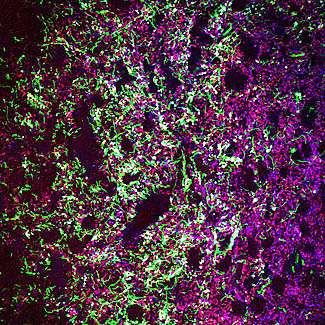'Dimmer switch' for mood disorders discovered

Researchers at University of California, San Diego School of Medicine have identified a control mechanism for an area of the brain that processes sensory and emotive information that humans experience as "disappointment."
The discovery of what may effectively be a neurochemical antidote for feeling let-down is reported Sept. 18 in the online edition of Science.
"The idea that some people see the world as a glass half empty has a chemical basis in the brain," said senior author Roberto Malinow, MD, PhD, professor in the Department of Neurosciences and neurobiology section of the Division of Biological Sciences. "What we have found is a process that may dampen the brain's sensitivity to negative life events."
Because people struggling with depression are believed to register negative experiences more strongly than others, the study's findings have implications for understanding not just why some people have a brain chemistry that predisposes them to depression but also how to treat it.
Specifically, in experiments with rodents, UC San Diego researchers discovered that neurons feeding into a small region above the thalamus known as the lateral habenula (LHb) secrete both a common excitatory neurotransmitter, glutamate, and its opposite, the inhibitory neurotransmitter GABA.
Excitatory neurotransmitters promote neuronal firing while inhibitory ones suppress it, and although glutamate and GABA are among two of the most common neurotransmitters in the mammalian brain, neurons are usually specialists, producing one but not both kinds of chemical messengers.
Indeed, prior to the study, there were only two other systems in the brain where neurons had been observed to co-release excitatory and inhibitory neurotransmitters – in a particular connection in the hippocampus and in the brainstem during development of the brain's auditory map.
"Our study is one of the first to rigorously document that inhibition can co-exist with excitation in a brain pathway," said lead author Steven Shabel, a postdoctoral researcher with Department of Neurosciences and neurobiology section of the Division of Biological Sciences. "In our case, that pathway is believed to signal disappointment."
The LHb is a small node-like structure in the epithalamus region of the brain that is critical for processing a variety of inputs from the basal ganglia, hypothalamus and cerebral cortex and transmitting encoded responses (output) to the brainstem, an ancient part of the brain that mammals share with reptiles.
Experiments with primates have shown that activity in the LHb increases markedly when monkeys are expecting but don't get a sip of fruit juice or other reward, hence the idea that this region is part of a so-called disappointment pathway.
Proper functioning of the LHb, however, is believed to be important in much more than just disappointment and has been implicated in regulating pain responses and a variety of motivational behaviors. It has also been linked to psychosis.
Depression, in particular, has been linked to hyperactivity of the LHb, but until this study, researchers had little empirical evidence as to how this overstimulation is prevented in healthy individuals given the apparent lack of inhibitory neurons in this region of the brain.
"The take-home of this study is that inhibition in this pathway is coming from an unusual co-release of neurotransmitters into the habenula," Shabel said. Researchers do not know why this region of the brain is controlled in this manner, but one hypothesis is that it allows for a more subtle control of signaling than having two neurons directly counter-acting each other.
Researchers were also able to show that neurons of rodents with aspects of human depression produced less GABA, relative to glutamate. When these animals were given an antidepressant to raise their brain's serotonin levels, their relative GABA levels increased.
"Our study suggests that one of the ways in which serotonin alleviates depression is by rebalancing the brain's processing of negative life events vis-à-vis the balance of glutamate and GABA in the habenula," Shabel said. "We may now have a precise neurochemical explanation for why antidepressants make some people more resilient to negative experiences."
More information: "GABA/glutamate co-release controls habenula output and is modified by antidepressant treatment," by S.J. Shabel et al. Science, 2014: www.sciencemag.org/lookup/doi/ … 1126/science.1250469



















